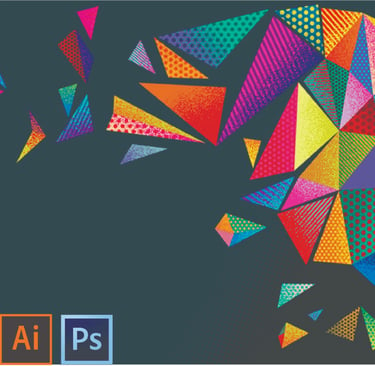Graphic design is the cornerstone of visual communication—an art form that combines creativity, skill, and strategy to craft powerful visual pereception and interaction. Yet today, the essence of graphic design is at risk of being overshadowed by the rise of quick-fix digital tools like Canva, which cater to convenience but often lack the depth and artistry of true design. Beyond the convenience of templates and apps, graphic design is more than drag-and-drop; graphic design is devoted to processing visual information using color, font and imagery (Photography, illustrations, graphics, and videos, all coming together to tell the brand story).
The reality is this: graphic design is not just about assembling text and images. It’s about delivering a message through a carefully constructed visual language that resonates with an audience. This process requires more than access to templates or software—it demands inherent creativity, fine art skills, and technical expertise honed through experience and training.
Respected tools of the trade—Adobe Illustrator, CorelDRAW, InDesign, Photoshop, After Effects and Premiere Pro—have long set the professional standard for design, layout, image manipulation, and video storytelling. These aren’t just programs; they are sophisticated creative environments that support the full spectrum of design thinking and execution. They empower designers to push boundaries, control every detail, and create work that’s both original and impactful.
I've been a graphic designer all my working life—starting from the days of drawing boards, Letraset sheets, and Rotring pens, when every layout was crafted by hand. We used Letraset dry transfer lettering to build text lines one character at a time—carefully cutting or rubbing each letter from the sheet and positioning it precisely on the artwork using tweezers, rulers, and set squares. With Cow Gum as our adhesive, we pasted images and bromide prints onto boards with meticulous attention to alignment and spacing. Once the layout was complete, we’d take the finished mechanicals across town to the lithographers for camera work and bromide reduction—where the artwork was photographed onto high-contrast bromide paper, reduced in size, and prepared for offset plate-making.
Then came the computer revolution. Suddenly, we moved from drawing boards to desktops. Early tools like WordPerfect and Aldus PageMaker began to change the game—allowing us to lay out text and graphics digitally, though still in a fairly clunky and linear way. PageMaker, in particular, was a breakthrough, giving designers the ability to work with pages, columns, and images onscreen in a way that mimicked traditional layout—but with the speed and flexibility of software. Aldus Corporation, the company behind PageMaker, pioneered desktop publishing and reshaped how we produced everything from books to brochures. What once took days of manual paste-up could now be done in hours, laying the groundwork for modern design software and forever changing the way we work.
But it was the rise of vector-based drawing tools like Adobe Illustrator and CorelDraw that truly transformed how we approached visual communication. Illustrator brought precision and scalability to illustration and typography, while CorelDraw—especially popular in early PC environments—offered powerful design capabilities for print and signage. These tools replaced technical pens and rulers with digital bezier curves and layers, opening a new world of creative freedom, speed, and control. What once required an arsenal of physical tools could now be done with a mouse, a screen, and an imagination. Adobe Illustrator was released in 1987 for the Apple Macintosh. It was Adobe’s first commercial product after PostScript and introduced the concept of vector drawing on screen using Bézier curves. CorelDraw was released later in 1989 for Windows by Corel Corporation. It was one of the first full-featured graphic design programs available for the Windows platform and gained popularity quickly, especially among PC users.
So much for history. Graphic design draws deeply from the roots of fine art, combining artistic vision with modern trends, tools, and functionality to create purposeful designs. In clear lingo, fine art is the mother of graphic design. While fine art stands for inborn talents, artistic skills, imagination and creative flair, graphic design combines all that with modern tools, trends, fashion and, of course, instruments and technology. And since we live in the post-modern age, graphic design has taken over from fine art regarding functionality and purpose in business. As a matter of fact, during the last century, graphic design emerged from fine art and photography to become a recognised profession within the Graphic Arts and Print Production disciplines and today is part and parcel of the kogs that drives the wheels of business, technology and industry, alongside architectural design, interior design, fashion design, product design, industrial design and print production. It is more; graphic design functions in multimedia design, web design and interactive media, and in film production - documentaries, jingles, TV entertainment, advertising and the Internet. The process of creating a graphic is an artistic process. The most successful graphic designers must always have a strong background in fine art. This is why the process of creating a graphic is referred to as illustration, and a finished graphic was in the near past referred to as an artwork or drawing. It is important to note that the term graphic (to mean a finished visual) is relatively new and came about in the 21st Century with the use of computer graphic design software such as CorelDraw and Illustrator. Before such software came into existence, graphic designers used to create artwork by hand on the drawing board using typography, instruments and coloured pigments. In the graphic design process, typography, typesetting and photography were skillfully combined by graphic designers and paste-up artists on the drawing board to create magazines, brochures, letterheads, business cards etc. Other services such colour separation, bromide reduction, film production and pre-print production (pre-press) were subcontracted to agencies and printers.
Historically, graphic design emerged as a profession that bridges the artistic and commercial worlds, influencing business, media, advertising, and technology. While platforms like Canva offer accessibility, they often reduce design to cookie-cutter outputs, diminishing the artistry and strategic thinking that seasoned designers bring to the table.
Creativity in graphic design terms feeds a lot on fine art. Creative minds are able to visualize and visualization is the hallmark of graphic design. This is because visualization is the first important step toward creating a concept for advertising, branding etc (together with marketing input) Training helps a lot in instilling discipline, techniques and adaptation of skills using the principles or Elements of Design. A well-trained designer visualizes concepts, leveraging principles of:
Unity Balance,
Harmony,
Contrast,
Rhythm (Repetition, Pattern)
Variety
Emphasis,
Proportion,
Funtionality,
Attraction (appeal) and
Aesthetics (the look),
to craft designs that aren’t just visually appealing but also strategically impactful. Graphic design is not a commodity to be exploited or oversimplified by those without proper training or artistic talent. It is a skilled profession requiring years of practice and a deep understanding of both artistic fundamentals and the evolving dynamics of branding and communication.
Successful brands—Coca-Cola’s iconic red, DHL’s golden yellow, Safaricom’s bottle green—are built on consistent, intentional graphic design. These visuals go beyond aesthetics; they form the essence of a brand’s identity, creating trust, recognition, and loyalty over time. Such outcomes cannot be achieved with shortcuts or generic templates.
As a senior graphic designer, I believe it is critical to push back against the dilution of our craft. Our profession deserves respect for its role in shaping visual culture and driving business success. Graphic design is not merely decoration; it’s a vital business tool, a creative discipline, and an art form that should be nurtured, not undermined.
Let’s champion the value of design rooted in talent, training, and artistry. Great design isn’t just about looking good—it’s about creating a lasting impact since the main function of visual design is to communcate effectively and inform.


Why Graphic Design Still Demands Mastery—Not Just Tools
J U NE 2 0 2 5

Bio
I'm Okang’a Ooko—a novelist and senior book designer with deep roots in publishing, storytelling, and design. I specialize in helping publishers and agents deliver polished, compelling books that resonate with their markets. Whether you’re producing high-volume titles or championing a first-time author, my design solutions ensure your books look as powerful as the stories they tell, captivating readers, and reflecting professional quality from cover to final page. As an author, my novels explore history, politics, culture, music, love, and identity—told through emotionally rich, character-driven narratives that captures nostalgia, societal conflict, and the personal struggles of those facing change and disconnection. Read more »
Ready to transform your story into something unforgettable? Okang'a Ooko specializes in end-to-end creative solutions for authors, publishers, literary agents, and storytellers. Whether you're crafting your first novel, launching a brand, or building an author platform, he's here to guide you from concept to creation. Learn more »
With decades of experience in storytelling, publishing, and visual design expertise. Ooko helps you bring your book, brand, or message to life—beautifully, strategically.
Turn your vision into a lasting impression. Hire Okang'a Ooko »
Hire Okang'a Ooko
Connect With Me
© 2025. All rights reserved.
Terms and Conditions I Refund Policy I Privacy Policy
